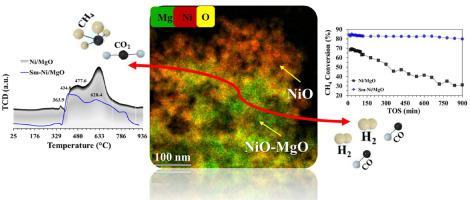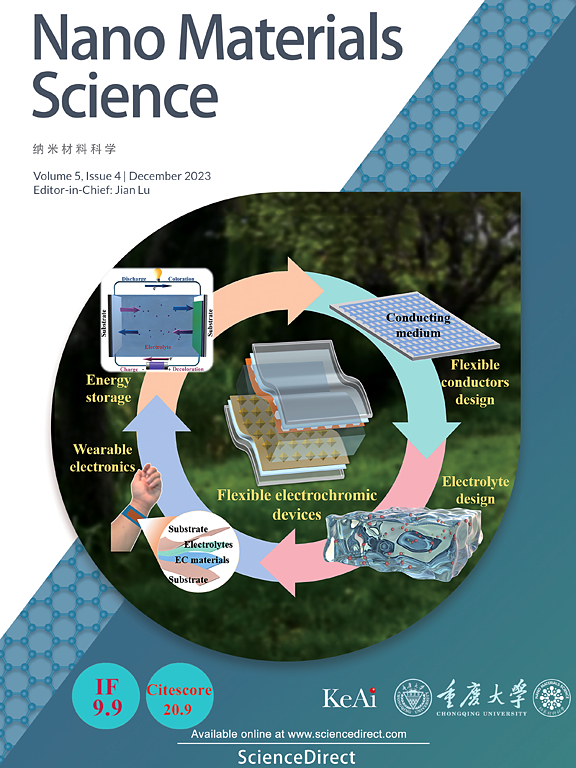Revisiting the mitigation of coke formation: Synergism between support & promoters' role toward robust yield in the CO2 reformation of methane
IF 17.9
2区 材料科学
Q1 Engineering
引用次数: 0
Abstract
CO2 reformation of methane (CRM) and CO2 methanation are two interconnected processes with significant implications for greenhouse gas reduction and sustainable energy production for industrial purposes. While Ni-based catalysis suffers from poor stability due to coke formation or sintering, we report a super stable remedy. The active sites of mesoporous MgO were loaded using wet impregnation. The incorporation of Ni and promoters altered the physical features of the catalysts. Sm–Ni/MgO showed the smallest crystallite size, specific surface area, and pore volume. The Sm–Ni/MgO catalyst was selected as the most suitable candidate for CRM, with 82 % CH4 and H2/CO ratio of approximately 100 % and also for CO2 methanation with the conversion of carbon dioxide (82 %) and the selectivity toward methane reaches 100 % at temperatures above 300 ᵒC. Furthermore, the Sm–Ni/MgO catalyst was stable for 900 min of continuous reaction, without significant carbon deposition. This stability was largely due to the high oxygen mobility on the catalyst surface in the presence of Sm. Overall, we demonstrated the efficacy of using promoted Ni catalysts supported by mesoporous magnesia for the improved reformation of greenhouse gases.


重新审视焦炭形成的缓解问题:在甲烷的二氧化碳转化过程中,支持和促进剂对提高产量的协同作用
甲烷的二氧化碳重整(CRM)和二氧化碳甲烷化是两个相互关联的过程,对减少温室气体排放和工业用可持续能源生产具有重要意义。镍基催化剂因形成焦炭或烧结而稳定性差,而我们报告了一种超稳定的补救方法。介孔氧化镁的活性位点是通过湿法浸渍负载的。镍和促进剂的加入改变了催化剂的物理特性。Sm-Ni/MgO 的结晶尺寸、比表面积和孔体积最小。Sm-Ni/MgO催化剂被选为 CRM 的最合适候选催化剂,其 CH4 转化率为 82%,H2/CO 比率约为 100%,还可用于 CO2 甲烷化,二氧化碳转化率为 82%,在温度高于 300 ᵒC时,对甲烷的选择性达到 100%。此外,Sm-Ni/MgO 催化剂在连续反应 900 分钟后保持稳定,没有明显的碳沉积。这种稳定性主要归功于催化剂表面在 Sm 存在下的高氧流动性。总之,我们证明了使用介孔镁支撑的促进镍催化剂在改善温室气体转化方面的功效。
本文章由计算机程序翻译,如有差异,请以英文原文为准。
求助全文
约1分钟内获得全文
求助全文
来源期刊

Nano Materials Science
Engineering-Mechanics of Materials
CiteScore
20.90
自引率
3.00%
发文量
294
审稿时长
9 weeks
期刊介绍:
Nano Materials Science (NMS) is an international and interdisciplinary, open access, scholarly journal. NMS publishes peer-reviewed original articles and reviews on nanoscale material science and nanometer devices, with topics encompassing preparation and processing; high-throughput characterization; material performance evaluation and application of material characteristics such as the microstructure and properties of one-dimensional, two-dimensional, and three-dimensional nanostructured and nanofunctional materials; design, preparation, and processing techniques; and performance evaluation technology and nanometer device applications.
 求助内容:
求助内容: 应助结果提醒方式:
应助结果提醒方式:


